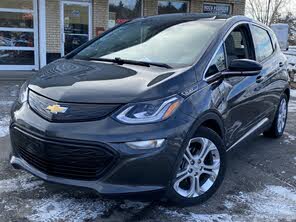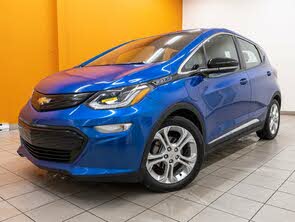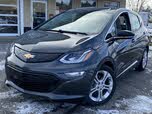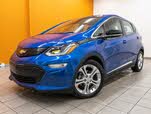Kia Soul vs Chevrolet Bolt EV
Overview | |
Years produced2010-Present | Years produced2017-Present |
MSRP$19,890 | MSRP$31,500 |
Average price$16,027 | Average price$23,585 |
Listings930 | Listings149 |
Ratings & Reviews | |
User Reviews | User Reviews |
Expert reviews7.7 out of 10 | Expert reviews8.0 out of 10 |
Pros
| |
Reviews SummaryThe Kia Soul demonstrates that good ideas mean nothing without good execution. Launched for the 2010 model year, the Soul instantly drew attention with its distinctive boxy styling. But unlike the similarly styled Honda Element and Scion xB, the Soul has managed to stick around. That’s because the Soul has style and substance in equal measure. It’s both a practical car and a good value, just one that happens to be more interesting to look at than most other vehicles sharing those traits. Now in its third generation, the Soul is an excellent compromise between car and crossover, boasting the tidy proportions of the former and the upright driving position of the latter. So, it makes sense to cross-shop it against both small hatchbacks and the gaggle of tiny crossovers that have hit the market since the Soul first appeared, such as the Hyundai Kona, Subaru Crosstrek, and Chevrolet Trax and Trailblazer. The current-generation Kia Soul was introduced for the 2020 model year and gets a number of notable updates for 2023, including some styling tweaks. In Canada, the trim line-up now includes LX, EX, EX+, EX Premium, and GT-Line Limited. We drove the U.S. equivalent of a Kia Soul GT-Line Limited for this review. | |
Reviews SummaryElectric vehicles are the future. Even racing and off-road enthusiasts have accepted this reality with the knowledge that EVs can be fun and engaging. We’ll lose the smell and the sounds, but one of the key purposes of racing is to improve the breed, so why not welcome the transition to electric propulsion? The 2022 Chevrolet Bolt EV could not be further from an enthusiast vehicle, but it’s just as important—if not more so—to the auto industry. Introduced for the 2017 model year and updated for 2022, the Bolt EV is the tip of GM’s EV spear. More EVs are coming, but it all starts here. For 2020, the Bolt EV's range from a full charge was increased to 417 kilometres. That carries over to 2022, and the Bolt EV gets standard DC fast charging as well, making it a more realistic option for more car shoppers. But is it enough to get you to make the leap to EV? | |
No video found | No video found |
Popular Features & Specs | |
Engine2.0L 147 hp I4 | Engine200 hp Electric |
Drive TrainFWD | Drive TrainFWD |
Seating Capacity5 | Seating Capacity5 |
Horsepower147 hp @ 6200 rpm | Horsepower |
EV Battery Capacity | EV Battery Capacity66 kWh |
MPG City28 | MPG City127 |
MPG Highway33 | MPG Highway109 |
Battery Charge Time (240V) | Battery Charge Time (240V)7 hours |
Engine | |
Engine Name2.0L 147 hp I4 | Engine Name200 hp Electric |
Torque132 lb-ft @ 4500 rpm | Torque |
Horsepower147 hp @ 6200 rpm | Horsepower |
Battery Charge Time (240V) | Battery Charge Time (240V)7 hours |
DrivetrainFWD | DrivetrainFWD |
Fuel Economy | |
EV Battery Capacity | EV Battery Capacity66 kWh |
MPG City28 | MPG City127 |
MPG Highway33 | MPG Highway109 |
Interior | |
Seating Capacity5 | Seating Capacity5 |
Safety | |
Front Crash Overall4 | Front Crash Overall5 |
Side Crash Overall5 | Side Crash Overall5 |
Dimensions & Capacity | |
Cargo Space24.2 cu ft | Cargo Space16.6 cu ft |
Curb Weight2888 lbs | Curb Weight3589 lbs |
Height63.0 in | Height63.4 in |
Length165.2 in | Length163.2 in |
Width70.9 in | Width80.3 in |
Wheelbase102.4 in | Wheelbase102.4 in |
Maximum Payload1135 lbs | Maximum Payload |
Number of doors4 | Number of doors4 |
Overview | ||
Years produced | 2010-Present | 2017-Present |
MSRP | $19,890 | $31,500 |
Average price | $16,027 | $23,585 |
Listings | ||
Ratings & Reviews | ||
User reviews | ||
Expert reviews | 7.7 out of 10Read full review | 8.0 out of 10Read full review |
Pros & cons | Pros
| |
Summary | The Kia Soul demonstrates that good ideas mean nothing without good execution. Launched for the 2010 model year, the Soul instantly drew attention with its distinctive boxy styling. But unlike the similarly styled Honda Element and Scion xB, the Soul has managed to stick around. That’s because the Soul has style and substance in equal measure. It’s both a practical car and a good value, just one that happens to be more interesting to look at than most other vehicles sharing those traits. Now in its third generation, the Soul is an excellent compromise between car and crossover, boasting the tidy proportions of the former and the upright driving position of the latter. So, it makes sense to cross-shop it against both small hatchbacks and the gaggle of tiny crossovers that have hit the market since the Soul first appeared, such as the Hyundai Kona, Subaru Crosstrek, and Chevrolet Trax and Trailblazer. The current-generation Kia Soul was introduced for the 2020 model year and gets a number of notable updates for 2023, including some styling tweaks. In Canada, the trim line-up now includes LX, EX, EX+, EX Premium, and GT-Line Limited. We drove the U.S. equivalent of a Kia Soul GT-Line Limited for this review. | Electric vehicles are the future. Even racing and off-road enthusiasts have accepted this reality with the knowledge that EVs can be fun and engaging. We’ll lose the smell and the sounds, but one of the key purposes of racing is to improve the breed, so why not welcome the transition to electric propulsion? The 2022 Chevrolet Bolt EV could not be further from an enthusiast vehicle, but it’s just as important—if not more so—to the auto industry. Introduced for the 2017 model year and updated for 2022, the Bolt EV is the tip of GM’s EV spear. More EVs are coming, but it all starts here. For 2020, the Bolt EV's range from a full charge was increased to 417 kilometres. That carries over to 2022, and the Bolt EV gets standard DC fast charging as well, making it a more realistic option for more car shoppers. But is it enough to get you to make the leap to EV? |
Video | No video found | No video found |
Popular Features & Specs | ||
Engine | 2.0L 147 hp I4 | 200 hp Electric |
Drive Train | FWD | FWD |
Seating Capacity | 5 | 5 |
Horsepower | 147 hp @ 6200 rpm | |
EV Battery Capacity | 66 kWh | |
MPG City | 28 | 127 |
MPG Highway | 33 | 109 |
Battery Charge Time (240V) | 7 hours | |
Engine | ||
Engine Name | 2.0L 147 hp I4 | 200 hp Electric |
Torque | 132 lb-ft @ 4500 rpm | |
Horsepower | 147 hp @ 6200 rpm | |
Battery Charge Time (240V) | 7 hours | |
Drivetrain | FWD | FWD |
Fuel Economy | ||
EV Battery Capacity | 66 kWh | |
MPG City | 28 | 127 |
MPG Highway | 33 | 109 |
Interior | ||
Seating Capacity | 5 | 5 |
Safety | ||
Front Crash Overall | 4 | 5 |
Side Crash Overall | 5 | 5 |
Dimensions & Capacity | ||
Cargo Space | 24.2 cu ft | 16.6 cu ft |
Curb Weight | 2888 lbs | 3589 lbs |
Height | 63.0 in | 63.4 in |
Length | 165.2 in | 163.2 in |
Width | 70.9 in | 80.3 in |
Wheelbase | 102.4 in | 102.4 in |
Maximum Payload | 1135 lbs | |
Number of doors | 4 | 4 |

By: CarGurus + AI
At CarGurus, our team of experienced automotive writers remain at the heart of our content operation, conducting hands-on car tests and writing insightful guides that are backed by years of industry experience. To complement this, we are harnessing AI to make our content offering more diverse and more helpful to shoppers than ever. To achieve this, our AI systems are based exclusively on CarGurus content, ratings and data, so that what we produce is both unique to CarGurus, and uniquely helpful to car shoppers.







































